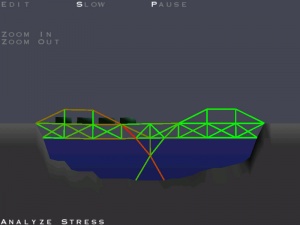Difference between revisions of "CS382:Structural-outline"
(→Lecture notes) |
(→Lab activity) |
||
| Line 34: | Line 34: | ||
[[Image:Bridge_builder.jpg|thumb|right | Bridge Builder]]Simple, effective, fun bridge building/simulation game. Illustrates structural stress with colors. Might be too simplistic, because it only simulates in 2 Dimensions. Additionally, the software appears to be non-free, and although there is a free 'demo' download for mac/windows. The demo appears fully functional, however the Bridge Builder website advertises a 3-D version with a paid licence. | [[Image:Bridge_builder.jpg|thumb|right | Bridge Builder]]Simple, effective, fun bridge building/simulation game. Illustrates structural stress with colors. Might be too simplistic, because it only simulates in 2 Dimensions. Additionally, the software appears to be non-free, and although there is a free 'demo' download for mac/windows. The demo appears fully functional, however the Bridge Builder website advertises a 3-D version with a paid licence. | ||
| − | The program is organized into 'Levels' ranging in difficulty from 'Level 1' and 'Level 15.' This could translate to a convient lab format, where we can assign a certain number of levels. There are some good videos on youTube that demonstrate the increased challenge of each subsequent level. [http://www.youtube.com/watch?v=r4qXl2736YU youTube:Level 6 - 14 in Bridge Builder] | + | The program is organized into 'Levels' ranging in difficulty from 'Level 1' and 'Level 15.' This could translate to a convient lab format, where we can assign a certain number of levels. There are some good videos on youTube that demonstrate the increased challenge of each subsequent level. |
| + | [http://www.youtube.com/watch?v=r4qXl2736YU youTube:Level 6 - 14 in Bridge Builder] | ||
2. Bridge Construction Set | 2. Bridge Construction Set | ||
| − | http://downloads.phpnuke.org/en/download-item-view-g-v-l-y-b/BRIDGE%2BCONSTRUCTION%2BSET.htm | + | [http://downloads.phpnuke.org/en/download-item-view-g-v-l-y-b/BRIDGE%2BCONSTRUCTION%2BSET.htm link title] |
| Line 44: | Line 45: | ||
An open source physics engine used in many applications. This came from a search on physics engines, which seem to be heavily related to modeling bridges and other structures. There might be some pedagogically useful aspects of this software, however delving to deep into the intracacies of linear algebra and vector multiplication might seriously confuse and frustrate many of the non-math people. | An open source physics engine used in many applications. This came from a search on physics engines, which seem to be heavily related to modeling bridges and other structures. There might be some pedagogically useful aspects of this software, however delving to deep into the intracacies of linear algebra and vector multiplication might seriously confuse and frustrate many of the non-math people. | ||
| − | + | '''Physical Models''' | |
1. K'nex would make an effective physical analogue to the computer simulation methods described above. It might make sense to instruct the students to build 2-dimensional K'nex models, in an effort to both simplify the process, and make the physical model the same as the bridge builder model. | 1. K'nex would make an effective physical analogue to the computer simulation methods described above. It might make sense to instruct the students to build 2-dimensional K'nex models, in an effort to both simplify the process, and make the physical model the same as the bridge builder model. | ||
Revision as of 18:55, 16 February 2009
Background reading
Note: Provide pointer to reading and some notes about it.
http://pghbridges.com/basics.htm - This is a page containing a number of basic types of bridges, and some information about their origin, and/or how they function.
http://www.in.gov/indot/files/bridge_chapter_01.pdf
Lecture notes
Note: Write in Outline Form
Note: The idea behind this unit is a 2-week unit exploring how it is possible to model structures such as bridges using 3D Modeling tools. Because our current software is biased towards the modeling and simulation of Bridges, this is what the unit will be based on modeling.
Lecture 1:
The first part of this lecture will be to explain the various types of bridges introduced in http://pghbridges.com/basics.htm . It should include an explanation of the various bridge types with an overview of how they function, as well as a brief history of each. (This is provided by the reading.)
Lecture 2:
Lecture 3:
Lecture 4:
Classroom response questions
Note: Include at least 3
Lab activity
Note: Include Process, Software, and Materials.
Simulations
1. Bridge Builder
Simple, effective, fun bridge building/simulation game. Illustrates structural stress with colors. Might be too simplistic, because it only simulates in 2 Dimensions. Additionally, the software appears to be non-free, and although there is a free 'demo' download for mac/windows. The demo appears fully functional, however the Bridge Builder website advertises a 3-D version with a paid licence.
The program is organized into 'Levels' ranging in difficulty from 'Level 1' and 'Level 15.' This could translate to a convient lab format, where we can assign a certain number of levels. There are some good videos on youTube that demonstrate the increased challenge of each subsequent level. youTube:Level 6 - 14 in Bridge Builder
2. Bridge Construction Set link title
An open source physics engine used in many applications. This came from a search on physics engines, which seem to be heavily related to modeling bridges and other structures. There might be some pedagogically useful aspects of this software, however delving to deep into the intracacies of linear algebra and vector multiplication might seriously confuse and frustrate many of the non-math people.
Physical Models
1. K'nex would make an effective physical analogue to the computer simulation methods described above. It might make sense to instruct the students to build 2-dimensional K'nex models, in an effort to both simplify the process, and make the physical model the same as the bridge builder model.
